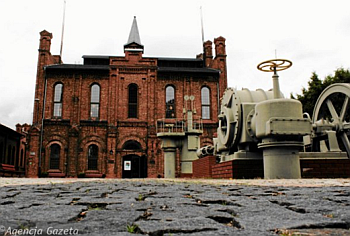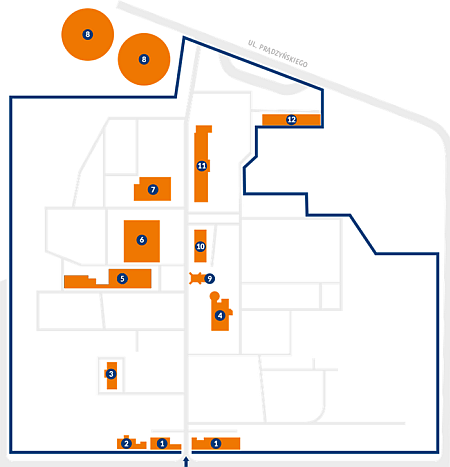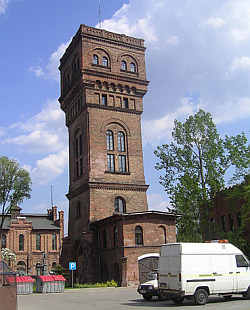Gasworks Museum

The Warsaw Gasworks is one of the most beautiful and best-preserved industrial architecture complexes from the turn of the 19th and 20th centuries.
During the Warsaw Rising, the Gasworks served as a shelter for residents of the city who survived the massacre.
History
In 1856, the city's Gas Committee signed a concession agreement with the German Continental Gas Association of Dessau for construction of gasworks. The agreement led to the construction of the city's first gasworks at Ludna Street in Powiśle. A much larger facility was built in 1886–1888 at Dworska Street (presently Kasprzak Street). A chemical factory was built next to it in 1892.
In 1925, the gasworks became property of the city, which established a company under the name of Gazownia Miejska m.st. Warszawy (Municipal Gasworks of the Capital City of Warsaw).
At the time, the company supplied gas to 90,000 households and 6,464 street lamps. In 1970, the gasworks discontinued production of gas from coal and shifted to producing municipal gas in a process of mixing natural gas with decomposition gas, which it stopped in 1978. Since 1978, Warsaw customers have been supplied only with natural gas.
Situated between Kasprzak Street and Prądzyński Street, the former gasworks complex consists of production buildings, two gas storage tanks, a water tower, a fire station, a vehicle station and office and residential buildings. Except for the two gas storage tanks, which are in private hands, the complex is managed by Polskie Górnictwo Naftowe i Gazownictwo (Polish Gas and Oil Company).
Since 1978, the former machine and compression station, which for many years served as a facility for compressing gas and sending it to end users, has housed the Gasworks Museum.
In 1925, the gasworks became property of the city, which established a company under the name of Gazownia Miejska m.st. Warszawy (Municipal Gasworks of the Capital City of Warsaw).
At the time, the company supplied gas to 90,000 households and 6,464 street lamps. In 1970, the gasworks discontinued production of gas from coal and shifted to producing municipal gas in a process of mixing natural gas with decomposition gas, which it stopped in 1978. Since 1978, Warsaw customers have been supplied only with natural gas.
Situated between Kasprzak Street and Prądzyński Street, the former gasworks complex consists of production buildings, two gas storage tanks, a water tower, a fire station, a vehicle station and office and residential buildings. Except for the two gas storage tanks, which are in private hands, the complex is managed by Polskie Górnictwo Naftowe i Gazownictwo (Polish Gas and Oil Company).
Since 1978, the former machine and compression station, which for many years served as a facility for compressing gas and sending it to end users, has housed the Gasworks Museum.
Some detailed information
It looks as if time has stopped in the old processing and compression station. An alley of gas lamps leads to the entrance. Inside there are historic devices used for production of the so-called coal gas. These powerful machines are 19th century ammonia scrubbers. Ten particularly well-preserved steam drive motors of impressive dimensions are a special attraction. They were in service until 1970.
The museum features also a mockup of a 19th century flat, where light and water heating were provided by coal gas. Several gas street lamps stand nearby. There is also an exhibition about Ignacy Łukasiewicz, the first person to distil crude oil.
The museum features also a mockup of a 19th century flat, where light and water heating were provided by coal gas. Several gas street lamps stand nearby. There is also an exhibition about Ignacy Łukasiewicz, the first person to distil crude oil.
Historic buildings and structures in the Warsaw Gasworks

2 - Director's house
3 - Vehicle station
4 - Central boiler station and chimney
5 - Museum, processing room building
6 - System I and II desulphurisation facility
7 - Ammonia facility
8 - Gas storage tanks
9 - Water tower and fire station
10 - Office building
11 - Laboratory building and experimental facility
12 - Central warehouse
Photographs

Water tower

Piston compressor

Gas storage tanks (view from Prądzyński Street)
Sources
- https://pl.wikipedia.org/wiki/Gazownia_Warszawska
- http://muzeum.gazownictwa.pl/
- http://warszawa.wyborcza.pl/warszawa/56,34862,17880647,muzeum-gazownictwa,,3.html
- https://pl.tripadvisor.com/Attraction_Review-g274856-d7066920-Reviews-Museum_of_Gas_Industry-Warsaw_Mazovia_Province_Central_Poland.html http://klimatwarszawy.pl/gazownia-warszawska-2/